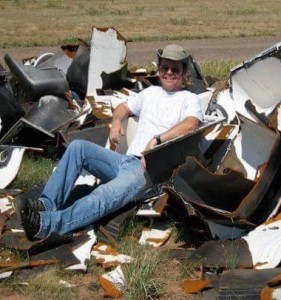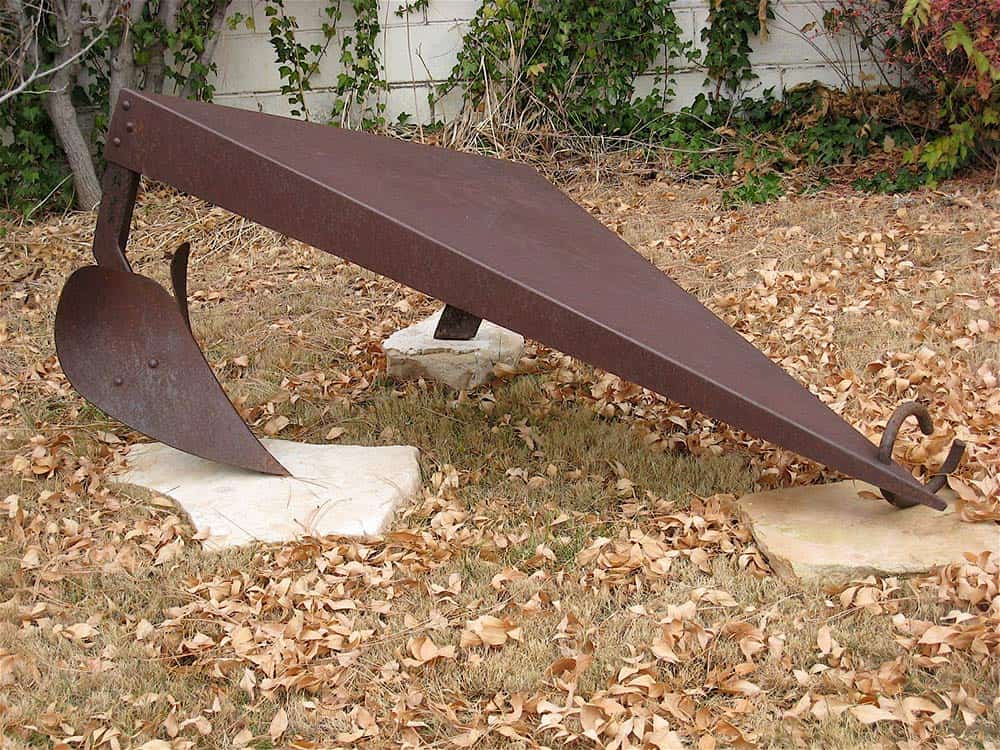Andrew John Cecil
As Andrew John Cecil was finishing up his M.F.A. at Cranbrook Academy of Art in the early 1980s, at a time when all his friends seemed headed for careers in New York, he made the conscious decision to go west, first to Texas and later New Mexico. It was a decision based both on ancestry and on an intuitive notion of where his true subject matter lay.
Cecil’s sculptures are indeed redolent of the West, both its romanticized aspects and the nitty gritty of daily life—on a farm or a ranch or just traveling the back roads, where you might spot a rusted-out car belly-up in an arroyo. An early work called Plow, for instance, references “the world I grew up with, the farming tradition,” he says. Another, Porcine/Bovine, could be a cow on one side and a pig on the other. “These are iconic elements of the American West,” he notes. But they are also sufficiently abstracted, even at this early date in Cecil’s career, that they fit neatly into the history of Modernist sculpture—as if Sir Anthony Caro had donned a Stetson for a brief foray into the American vernacular.
Cecil grew up in the wide open spaces. His father was a minister and an historian who traveled all over the Western states. The artist recalls going to camp meetings as a boy: “It was a way to talk about Scripture and share in community,” he recalls. Something of his childhood returned to him when he made his first foray into cast-iron sculpture, in a work called Tonka (1998). The title refers to Tonka trucks– “it was a ubiquitous form that boys grew up with during the 1950s and ‘60s,” he says. “We would build roads and dams with these, and it became a tool for another identity. The Tonka was the toy that was left out in the yard, and when it was forgotten and then dug up again. it became this artifact of childhood.”
Some of Cecil’s cast-iron sculptures bring to mind toys—miniature fences, tools, and vehicles–but they possess a strange and poetic monumentality, even on a diminutive scale, in part because of their scarred and scraped surfaces, in part because of the heavy material from which they are cast. In some, Cecil has incised words, generally indecipherable, suggesting messages left by members of an ancient tribe.
Cast iron has been enjoying a revival in recent years, with international exhibitions at sites like Grounds for Sculpture in Hamilton, New Jersey. The process is similar to that for casting bronze, basically a lost-wax procedure using a ceramic-shell mold. “It takes a group of people to produce a cast-iron work,” Cecil points out. “There’s a hands-on, go get ‘em, American-type attitude involved.”
After a work is cast and painted, the artist then buries the sculpture in the yard of his home and studio in Roswell, NM, for three to six months. That produces a scruffed-up patina, along with soil embedded in some of the cracks and crevices. “I like digging something up and having that feel of soil on the work,” says Cecil, and there is a hint of childish surprise in his voice, as though making the connection with that Tonka truck found abandoned so long ago.
In spite of the time-consuming and labor-intensive process that goes into his sculpture—or perhaps because of it—the artist begins his day with drawings, a daily exercise that has filled sketchbooks since 1979. “I’m constantly looking for the anomaly, for something I haven’t seen before, for the unexpected,” he says. “Fifteen years ago I started to draw these very simple images of boxes, and they’re all based on the idea of the toolbox, another iconic American image. The sculpture Red Box came out of these very simple direct drawings. It’s happened again and again, and it’s where I find my source material.”
Ann Landi
 Andrew John Cecil’s most recent show was “Go West” at Gerald Peters Gallery in Santa Fe. He has exhibited in many national and international venues, including the Toyamura International Sculpture Biennale and the Koumi Machi Kougen Museum of Art in Japan. More about his work can be found at andrewjohncecil.com.
Andrew John Cecil’s most recent show was “Go West” at Gerald Peters Gallery in Santa Fe. He has exhibited in many national and international venues, including the Toyamura International Sculpture Biennale and the Koumi Machi Kougen Museum of Art in Japan. More about his work can be found at andrewjohncecil.com.
Photo credit: Bareback (1991), steel, 11 by 18 by 8 inches


Wonderful work. Thank you for bringing John Cecil to my attention. I hope you are feeling better.